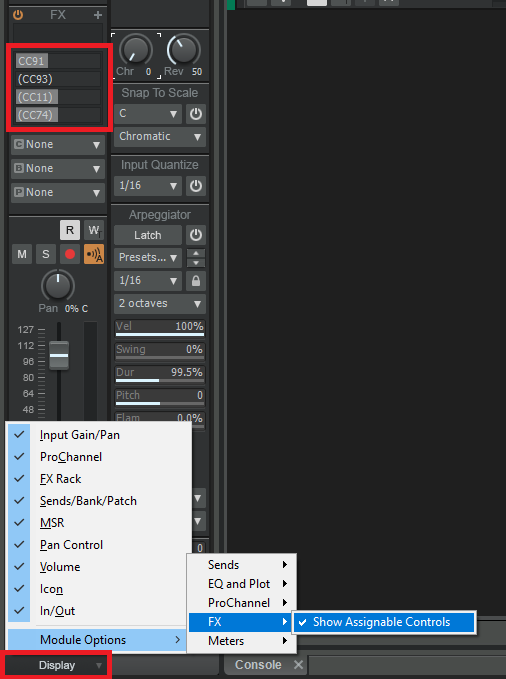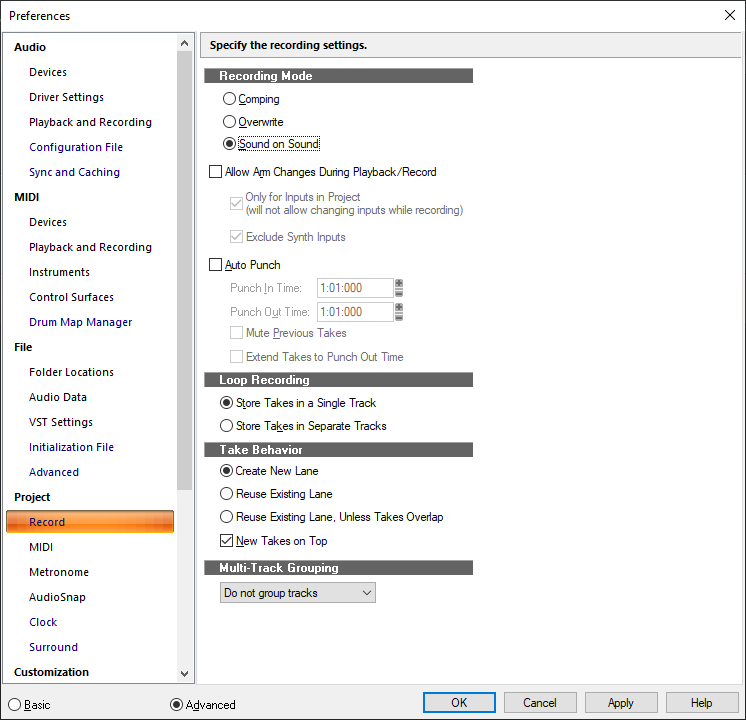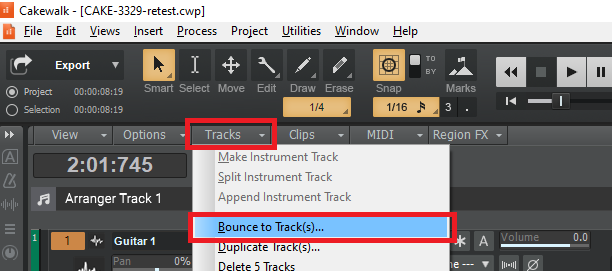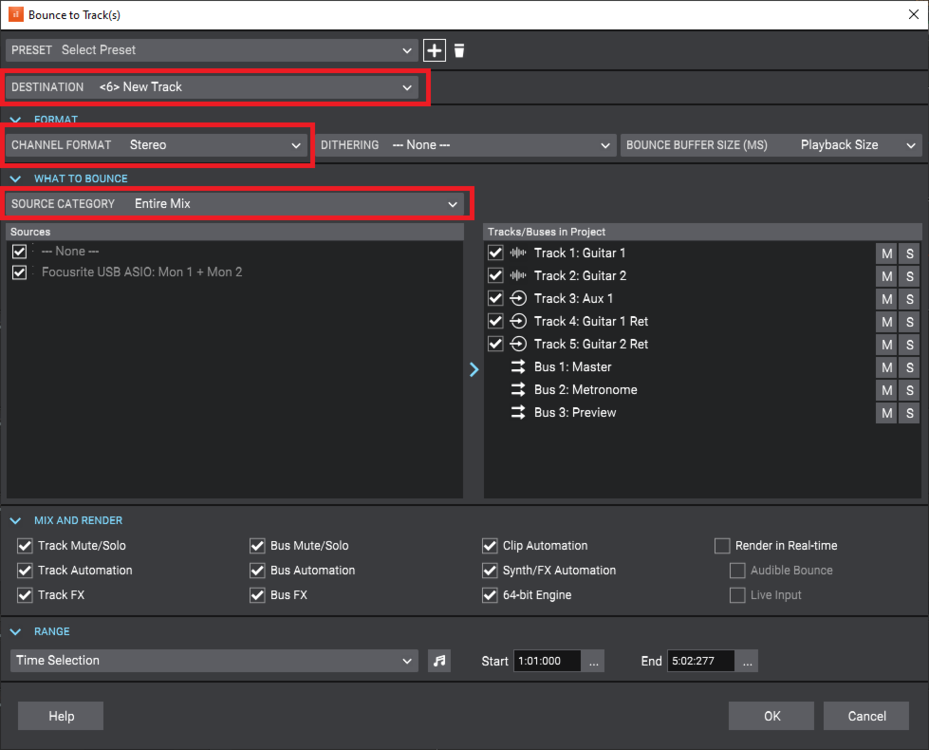-
Posts
7,191 -
Joined
-
Last visited
-
Days Won
39
Everything posted by msmcleod
-
Chorus and Reverb ( CC91 / CC93 ) are already on the MIDI Track. If you enable Assignable Controls, you can control up to another 4 of them - not your whole list obviously, but at least you'll get 6 of them. Saving the track as a track template will retain the assignable controls:
-
I'm certainly not getting that here, certainly not with MIDI tracks routed to an instrument track. All I'm doing: 1. Insert Addictive Drums 2 as an instrument track 2. Arm the track 3. Set recording mode to Sound on Sound, with the following options: 4. Create my loop points, and hit R. I built up a track starting with kick drum, then hi-hat, then snare. All of my previous takes are heard, and I'm not hearing any doubling up of notes. I think @David Baay probably hit the nail on the head: Disable MIDI out on your plugin and/or don't use Omni as an input. In my case Omni was on, but no plugin had MIDI out enabled. If MIDI out was enabled on an instrument, setting the MIDI input to only listen on your MIDI controller/keyboard would stop it from receiving anything other than what you're playing and the previous takes. FWIW, I don't think that having MIDI out in itself is necessarily a problem in itself, but many VSTi's repeat what they've received through their MIDI output - and this is the issue if you've got your track input set to Omni.
-
I'd recommend re-installing the latest VC++ runtime. Noel provides a link here:
-

Channel Number for Non-note MIDI Events
msmcleod replied to Keith Wilby's topic in Instruments & Effects
Whether rightly or wrongly, Event Inspector only changes the MIDI channel of note events - the text in the help module says as much. This usually isn't an issue as most users will change the MIDI channel, which will override the channel of all recorded events in any of the track's clips. Alternatively, as @rfssongs suggests, you can use Process Find/Change. -
This isn't a Control Surface DLL issue - it's a SONAR issue. The issue with control surfaces "stealing" MIDI input ports was a problem in SONAR for many years, and was only recently fixed about a year or so ago in Cakewalk by BandLab. CbB now remembers the name of the MIDI port as well as the port number used by a control surface. If the MIDI port for the control surface's port number has a different name, CbB now disables the port on the control surface. Also, FWIW... all of the functionality contained within the MMcL Mackie Control dll is present in CbB's own Mackie Control implementation. Unless you've not got CbB installed, or you want additional independent Mackie control surfaces running at the same time as the Cakewalk one, there's no need to use the MMcL Mackie Control version.
-
One's I know work, because I've used them: Mackie MCU / Mackie MCU Pro ( and also XT / C4 ) - use the SONAR lexan overlay with the MCU / MCU Pro Korg nanoKONTROL 2 Korg nanoKONTROL Studio Presonus FaderPort 8 / FaderPort 16 One's I believe work, based on reports from others: Behringer X-Touch ( the large one ) + X-Touch Extender - as far as I can tell, these are direct clones of the Mackie MCU / XT. You'll need a custom overlay for them though, which are available through 3rd parties, or you can make one yourself. Older devices I know work, because I've used them: Behringer BCF2000 Yamaha 01X (either through mLAN if you can get the drivers working, or via the internal MIDI modification dongle) Any device that supports Mackie MCU mode, and has a specific SONAR / Cakewalk mode will work. Any device that supports Mackie MCU mode, and has a Cubase mode, will mostly work in CbB's "Cubase Emulation Mode" - by that I mean the faders, v-pots and transport / looping / marker buttons should work. Bear in mind these are all based on the Mackie MCU protocol, which is primarily concerned with transport / fader control. Although you can use them for controlling plugins, you can't use ACT learn. Instead you have to provide a v-pot/parameter mapping for each plugin in MackieControl.ini, when then becomes a static mapping for those parameters. My C4Mapper utility provides a drag/drop UI for editing the MackieControl.ini file. Although primarily designed for the C4, it'll work for the MCU if you restrict yourself to the top 8 v-pots.
-
To be honest, I think this is pretty common behaviour among many delay plugins. If you've got a tempo-sync'd delay, and you change the tempo mid-way through, it's gonna sound weird. I've heard everything from clicks & pops, to stuttering and strange pitch sweeps. Even adjusting the delay time in real time through a delay plugin's UI will give similar results - and I've seen similar behaviour with hardware digital delays as well. To stop this behaviour, use two delays and use automation on the delay's bypass or input level to switch one off and the other on at the point of the tempo change. If you've got a smooth tempo change, it's more complex to solve, but you can normally get away with calculating the equivalent ms time for the tempo and setting it to that rather than sync'ing to tempo and leaving it on that setting until you switch over to the other delay. Alternatively, you may find a delay which behaves better with dynamically changing the delay time while in use.
-

Help with prior versions and opening/splash screen
msmcleod replied to Mark Bianchino's question in Q&A
It looks like it's launching the SONAR Platinum start page application instead of the Cakewalk by BandLab (CbB) one. I seem to remember a similar thing happening to me when OneDrive was set up on more than one machine with the same account, and it was clobbering the files on one machine with files from the other. Re-installing CbB should fix this. -
There's a setting in JBridge that specifically deals with this issue AFAIK... have you checked the JBridge config for that plugin?
-
CTRL + A to select all (or just select the tracks you want), then from the clips view menu, Tracks -> Bounce to Track(s): You want the following options in the bounce dialog:
-
I was using it in SONAR Platinum with my 01X recently, but that was on a 32 bit build. OPT is COM based so it wouldn't surprise me if it was a 32 bit only technology. Also, SONAR only ever supported OPT level 1, which was the first version that came out at around the time of SONAR 3.
-

Extertnal Insert - De Coupling not working
msmcleod replied to El Gato Loco's topic in Instruments & Effects
@El Gato Loco - this bug has been fixed in the latest EA, so my original instructions for the workaround should now work: -
@IainThompson - I didn't realise you were using the nanoKONTROL 2... it could be that your control surface settings file has been corrupted. Try renaming ctrlsurface.dat to ctrlsurface.old within %APPDATA%\Cakewalk\Cakewalk Core\
-
It's a pity, because there really isn't anything out there that does the same thing - the filters are amazing, but totally proprietary. The only other option is getting a 2nd hand hardware Morpheus, UltraProteus, or Emulator E6000 - all of which are rare & expensive.
-
The answer is yes, but it's REALLY complicated to set up. It involves using MIDI loopback devices, and either aggregate ASIO drivers or audio loopback devices. First of all though, have you tried running the ProteusVX via JBridge instead of BitBridge?
-
It's hard to give a definitive answer without knowing much more detail about your system, but the fact that you say it improved when you moved to an SSD leaves me to suspect this is simply due to some of the instrument samples having not been loaded yet. A lot of sample based VSTi's load samples on demand - i.e. they'll only load the C3 at velocity 64 sample when you actually play it. Some also have a limit as to how much memory they'll use for samples before they swap out older samples (i.e. ones that haven't been played for a while) for newer ones. This behaviour is usually configurable within the VSTi plugin itself. Although some VSTi's allow you to load ALL of the samples up front, this isn't usually desirable as: 1. It'll use up an enormous amount of memory 2. It'll take ages to load them all 3. You probably won't be using every note, at every velocity over 6-8 octaves. Well written VSTi's should remember which notes were played, and therefore which samples you actually need within a session. It should then load these samples upon opening your project. You usually have to play your project all the way through first before saving your project for it to have an accurate idea of this though.
-
You just need to pan Channel 1 hard left, and Channel 2 hard right on the mixer. Make sure you're not using any of the mixer's in-built FX. In Cakewalk create two audio tracks, one with the input set to the Left channel only and the other to the Right channel only. Then arm them both and hit record.
-
Cakewalk Pro Audio 9 was designed for Windows 95, 98 and NT. Windows 95 & 98 were 16 bit, and Windows NT was 32 bit. Since NT, there has been Windows 2000 / ME, Windows XP, Windows Vista, Windows 7, Windows 10 and now Windows 11. Although CWPA9 uses standard Windows API's, those have likely changed over the past 23 years - and certainly in the case of security, significantly so. So it's not surprising that CWPA9 doesn't quite behave as expected on Windows 10. All the 32 bit versions of Windows can run both 32 bit and 16 bit programs. The 64 bit versions of Windows can only run 64 bit and 32 bit programs. I don't know if there are any 16 bit components to CWPA9, but if there are, they definitely won't work in Windows 10 64 bit. If you've got a 32 bit version of Windows 10, it may behave better. Personally, I'd stick to Windows XP if you can for running CWPA9. You can install it on a separate drive and have a dual boot with Windows 10 if necessary. You could also try running Windows XP as a virtual machine. VirtualBox by Oracle is free, and I run an XP virtual machine to run old 16 bit patch editors, and also CWPA9! The only other thing I can suggest is, in addition to running it in compatibility mode, make sure CWPA9 is running as administrator.
-
The best performing audio drivers in order are: ASIO (lowest latency [i.e. smallest delay]) WASAPI Exclusive WASAPI Shared WDM MME ASIO4ALL is simply a wrapper around WDM to make it look like an ASIO driver, but it's basically using WDM under the hood. If the manufacturer of your audio interface has a real ASIO driver, then install it and use that, otherwise try WASAPI Exclusive or WASAPI Shared. If you're using the on-board audio device in your computer, you definitely should be using one of the WASAPI modes - avoid the Realtek ASIO driver - it doesn't work. Lowering the buffer size in Preferences->Audio->Driver Settings will reduce the latency, but increases CPU usage. If the CPU usage is too high, you'll get pops & clicks and/or drop-outs. If the buffer size is too high, you'll get increased latency - in other words delay between playing a note and hearing it. For recording/playing in real-time, you want the output latency less than 10ms, ideally less than 5ms. But unless you absolutely have no other option, you should uninstall ASIO4ALL.
-

FR: Accepting comma as decimal point, and minus sign at numpad
msmcleod replied to FrankP's topic in Feedback Loop
@FrankP - AFAIK, this should work in most places assuming your language / locale are set accordingly. Is there a specific instance where it isn't working? -
You should be fine working offline. Cakewalk only needs to be re-activated once every 6 months. If your Cakewalk PC is never online, you can use BandLab Assistant on another PC that is online to do the offline activation for you. Instructions on how to do this are here: https://help.cakewalk.com/hc/en-us/articles/900006210046-Activating-Cakewalk
-
I use a 23" 1920x1080 monitor in my office (well 3 of them, but Cakewalk is only ever on one of them), and that's fine for me with my reading glasses on. I'm about 1 meter away. In the studio I use a single 27" 1920x1080 monitor at just under 1.5 meters away, which is perfect. I still have to wear my reading glasses though, as anything less than 2 meters away is a struggle without them. I did try a 32" TV at one point, but it just felt way too big.
-

MACKIE CONTROL - LAYER 2 FUNCTION KEYS MAPPING
msmcleod replied to El Gato Loco's topic in Instruments & Effects
I guess there's no technical reason why this couldn't be done, but it'd require a non-trivial amount of development work. The biggest issue would be the UI redesign... and those dropdown lists take AGES to populate, so it would take twice as long to open up the Mackie Control dialog. This IMO would override any benefit from having the extra function mappings. In saying that, there's nothing stopping someone doing this themselves - the code is on github: https://github.com/Cakewalk/Cakewalk-Control-Surface-SDK -

How do I get classic General MIDI synth sounds?
msmcleod replied to Dave G's topic in Instruments & Effects
Ah... the MT-32... I released an album back in '94 where over half the sounds were from an MT-32. The other half were from a CM-32P (the desktop version of the U110). I ended up writing my own MT-32 patch editor for the Amiga 500. I've sampled most of the MT-32 sounds I used, and still use some of them today.







